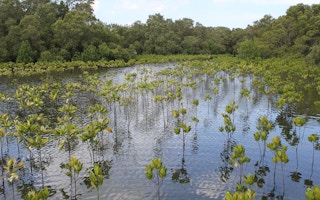If sea levels go on rising at ever higher rates, then by 2050 the world’s mangrove forests could be obliterated, drowned by rising tides.
Mangrove forests cover between 140,000 and 200,000 square kilometres of the intertidal zones that fringe more than 100 tropical and subtropical countries, and have become among the richest ecosystems of the planet.
They are estimated to store at least 30 million tonnes of atmospheric carbon each year, and a couple of sq kms of this saltwater forest can harbour nursery space for what could become 100 tonnes of commercial fish catch every year.
They also provide shelter for a huge range of creatures, including an estimated 500 Bengal tigers in the vast Sundarbans mangrove forests along the Ganges-Brahmaputra delta.
And while most of the 80 or so species of mangrove tree can keep up with an annual sea level rise of around 5mm a year, they seem unlikely, on evidence from the past, to be able to survive a 10mm rise. Right now, the world is heading for the higher end of the scale.
Sheltering people
A second and separate study finds that, importantly for humans, along with coral reefs, the mangrove forests provide vital natural protection from tropical storms for 31 million very vulnerable people in North and Central America and the crowded archipelagos of Indonesia and the Philippines.
Researchers from Australia, China, Singapore and the US report in the journal Science that they looked at the evidence locked in the sediments in 78 locations from the last 10,000 years, to work out how mangrove forests have – through the millennia – responded to changes in sea level.
At the close of the last ice age, sea levels rose at 10mm a year and slowed to nearly stable conditions 4000 years ago.
In a high emissions scenario, by 2050 sea level rise would exceed 6mm: the scientists found a 90 per cent probability that mangroves would not be able to grow fast enough to keep up. Nor – because of the development of coastal settlements worldwide – would the forests be able to shift inland.
“This research therefore highlights yet another compelling reason why countries must take urgent action to reduce carbon emissions,” said Benjamin Horton of Nanyang Technical University in Singapore, one of the researchers.
“Mangroves are among the most valuable of natural ecosystems, supporting coastal fisheries and biodiversity, while protecting shorelines from wave and storm attack across the tropics.”
As so often happens in research, confirmatory evidence of the importance of mangroves had been published only days earlier, in the Public Library of Science journal PLOS One.
US researchers found that – in the Gulf of Mexico and the Caribbean, off the coasts of east Africa and in the Indo-Pacific – a total of 30.9 million people lived in regions vulnerable to powerful tropical storms such as Typhoon Haiyan and Hurricane Harvey.
Of these, more than 8 million people were offered severe weather protection by shoreline mangrove forests and coral reefs, both of which absorb wave energy, reduce wave heights and keep coastal settlements safer.
Not enough protection
But only 38 per cent of mangroves and 11 per cent of coral reefs along the vulnerable coastlines are protected, they found.
A 100-metre screen of shoreline mangrove forest can reduce wave heights by as much as two-thirds. By 2100, coastal floods could be costing the world’s nations US$1 trillion a year in economic damage.
Geographers have argued for decades that natural protection is the most efficient way of saving lives and settlements from the storm surges and flooding associated with tropical cyclone extremes.
“Simply put”, said Holly Jones of Northern Illinois University, who led the research, “it’s much cheaper to conserve a mangrove than build a sea wall.”
This story was published with permission from Climate News Network.










